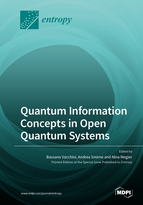Quantum Information Concepts in Open Quantum Systems
A special issue of Entropy (ISSN 1099-4300). This special issue belongs to the section "Quantum Information".
Deadline for manuscript submissions: closed (30 September 2022) | Viewed by 19955
Special Issue Editors
2. Istituto Nazionale di Fisica Nucleare, Sezione di Milano, via Celoria 16, 20133 Milan, Italy
Interests: open quantum systems; foundations of quantum mechanics; decoherence
2. Istituto Nazionale di Fisica Nucleare, Sezione di Milano, via Celoria 16, 20133 Milan, Italy
Interests: open quantum systems; quantum metrology; foundations of quantum mechanics
2. Istituto Nazionale di Fisica Nucleare, Sezione di Milano, via Celoria 16, 20133 Milan, Italy
Interests: open quantum systems; quantum information; quantum thermodynamics
Special Issue Information
It has long been recognized that a key feature in determining the behavior of a quantum system is the interaction with the other surrounding quantum degrees of freedom. This aspect is crucial in foundational studies of quantum mechanics aiming at the description of the quantum measurement process. At the same time, it plays a decisive role in the exploitation of quantum effects, especially in view of the implementation of quantum information schemes, quantum thermodynamic devices, and quantum technology applications. The theory of open quantum systems addresses all these challenges. Recent developments in the field have, however, shifted the activity toward considering and understanding the relevance of correlations, both of classical and quantum nature, in the description of the dynamics and measurement of open quantum systems. Indeed, duly keeping correlations into account both at the initial time and in the course of the evolution is a crucial requirement to pave the way for experimental advancements in the field of open quantum systems.
Prof. Dr. Bassano Vacchini
Dr. Andrea Smirne
Dr. Nina Megier
Guest Editors
Manuscript Submission Information
Manuscripts should be submitted online at www.mdpi.com by registering and logging in to this website. Once you are registered, click here to go to the submission form. Manuscripts can be submitted until the deadline. All submissions that pass pre-check are peer-reviewed. Accepted papers will be published continuously in the journal (as soon as accepted) and will be listed together on the special issue website. Research articles, review articles as well as short communications are invited. For planned papers, a title and short abstract (about 100 words) can be sent to the Editorial Office for announcement on this website.
Submitted manuscripts should not have been published previously, nor be under consideration for publication elsewhere (except conference proceedings papers). All manuscripts are thoroughly refereed through a single-blind peer-review process. A guide for authors and other relevant information for submission of manuscripts is available on the Instructions for Authors page. Entropy is an international peer-reviewed open access monthly journal published by MDPI.
Please visit the Instructions for Authors page before submitting a manuscript. The Article Processing Charge (APC) for publication in this open access journal is 2600 CHF (Swiss Francs). Submitted papers should be well formatted and use good English. Authors may use MDPI's English editing service prior to publication or during author revisions.
Keywords
- quantum correlations in OQS
- information flow in OQS
- non-Markovianity
- initial correlations
- quantum measurement
- quantum incompatibility
- entropic inequalities in OQS
- quantum coherence in OQS







